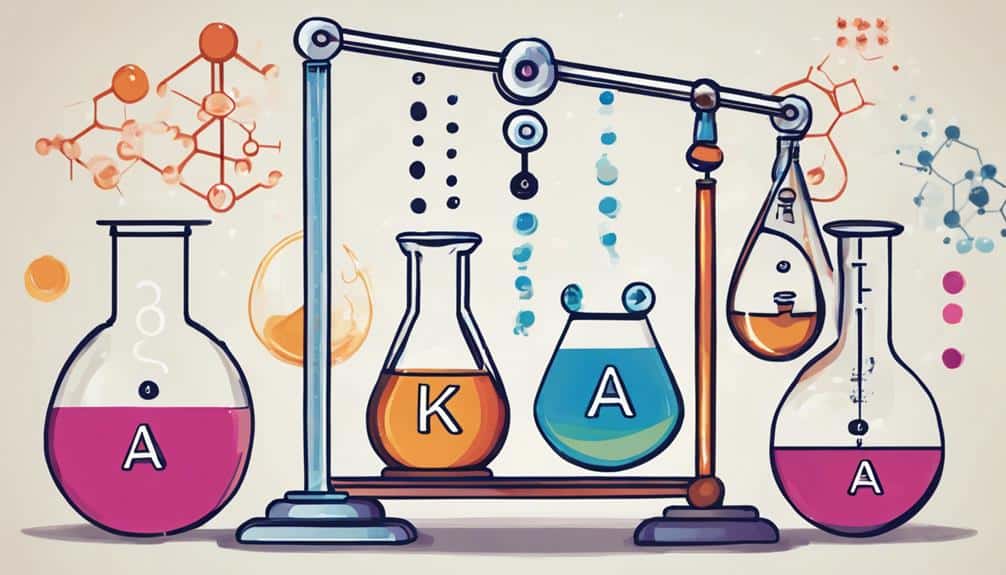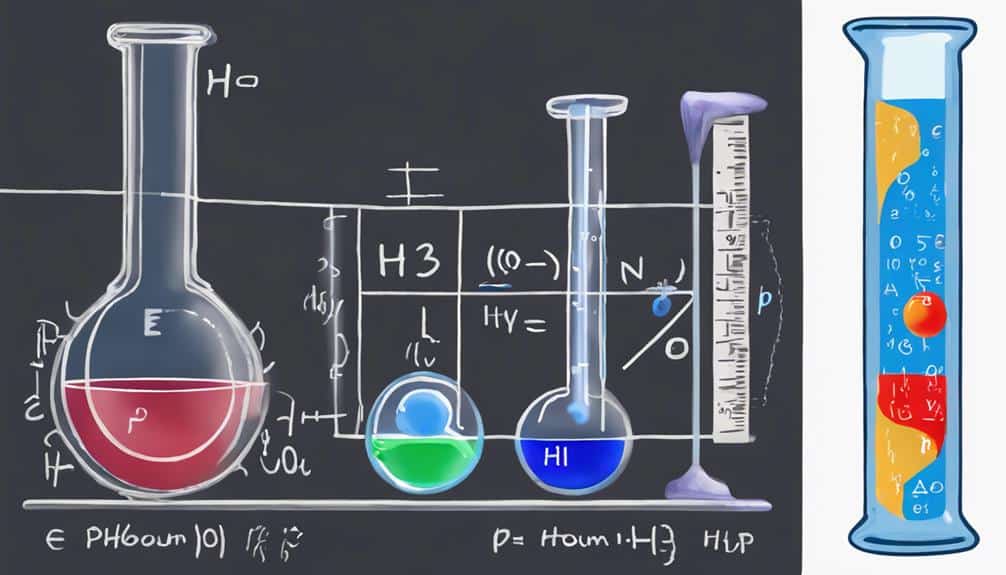You can calculate the pH of a weak acid solution using its Ka value by following a 3-step process. First, set up an ICE table, listing the reactants and products of the acid dissociation reaction, and assign initial concentrations. Next, establish the equilibrium equation, representing the balance between reactants and products, and express the equilibrium constant expression (Ka). Finally, solve for the concentration of hydrogen ions (H3O+) by plugging the Ka value and initial acid concentration into the equilibrium expression, and calculate pH using pH = -log[H3O+]. Now, you're ready to uncover the precise pH of your weak acid solution.
Key Takeaways
• Set up an ICE table to track concentration changes, listing reactants and products, with initial concentrations of 0 for products and the acid's initial concentration for the reactant.
• Establish the equilibrium equation for the weak acid HA, representing the balance between reactants and products, with the equilibrium constant expression Ka = [H+][A-]/[HA].
• Plug the Ka value and initial acid concentration into the equilibrium expression to solve for x, the concentration of H3O+ ions, using algebraic methods.
• Calculate pH using pH = -log[H3O+] after solving for the concentration of H3O+ ions.
• Use the Ka value specific to the acid and temperature of the solution to ensure accurate calculations.
Set Up the ICE Table
Set up your ICE table by listing the reactants and products of the acid dissociation reaction, assigning initial concentrations of 0 to the products and the initial concentration of the acid to the reactant. This is the foundation of calculating pH from Ka, as it allows you to track the changes in concentration during the reaction.
As you create your ICE table, remember that you're working with a weak acid, which only partially dissociates in water.
In the Initial row, list the reactant (the undissociated acid) and its initial concentration. Since the products (hydrogen ions and conjugate base) aren't present initially, assign them a concentration of 0.
The Change row will show how the concentrations change as the reaction proceeds, but for now, focus on setting up the table correctly.
With your ICE table in place, you'll be ready to calculate the equilibrium constant Ka, which is essential for determining pH. By mastering this step, you'll be one step closer to accurately calculating pH from Ka, a fundamental concept in chemistry.
Establish the Equilibrium Equation

Now that you've set up your ICE table, you're ready to establish the equilibrium equation, which represents the balance between the reactants and products of the acid dissociation reaction. This equation is important in understanding the relationship between the reactants and products.
For a weak acid HA dissociating into H+ and A-, the equilibrium equation is:
HA ↔ H+ + A-.
The equilibrium constant expression (Ka) for this reaction is:
Ka = [H+][A-]/[HA],
which helps quantify the extent of acid dissociation in the aqueous solution.
As you calculate pH from Ka, it's crucial to use the Ka value and the initial concentration of the weak acid. The Ka value is a constant that depends on the specific acid and the temperature of the solution.
By using the equilibrium equation and the Ka value, you can determine the concentration of H+ ions, which is directly related to the pH value of the solution.
Solve for H3O+ Concentration

You'll need to solve for the concentration of H3O+ ions in the solution, which involves plugging the given Ka value and initial concentration of the weak acid into an equilibrium expression and then solving for x, the concentration of H3O+ ions produced from the dissociation of the weak acid. This is where the algebraic skills come into play.
Plug in the values into the equilibrium expression and solve for x using algebraic methods. Once you've set up the equation, solve for x, which represents the concentration of H3O+ ions.
When you've found the concentration of H3O+ ions, you can calculate the pH using the equation pH = -log[H3O+]. This pH equation is essential in finding the pH of a solution, given the Ka value and initial concentration of the weak acid.
In the context of weak acids, the acid dissociates to produce hydrogen ions, which affect the pH of the solution. By solving for the concentration of hydrogen ions, you can find the pH of the solution. Remember to balance the terms in the equation and use the initial concentration of the weak acid to set up the equilibrium expression correctly.
Frequently Asked Questions
How Do You Calculate Ph From Ka?
You're wondering how to calculate pH from Ka. To do so, you'll need to understand the relationship between the two.
pH is directly related to the acid dissociation constant, Ka. Simply plug the Ka value into the equation pH = -log(Ka), and you'll get the pH of the solution.
This calculation is essential in understanding the behavior of weak acids, allowing you to predict their reactions and properties.
What Are the Steps to Calculate Ph?
As you begin this scientific journey, envision revealing the secrets of acidic mysteries!
To calculate pH, you'll need to follow a few essential steps.
First, identify the weak acid and its Ka value, which indicates the extent of acid dissociation.
Then, set up an ICE table to determine the concentrations of acid and its ions.
How to Calculate Ph From Pka?
You're wondering how to calculate pH from pKa. To start, you'll need to understand the Henderson-Hasselbalch equation:
pH = pKa + log([A-]/[HA]).
This equation simplifies pH calculations for weak acid solutions.
By knowing the pKa and concentrations of the acid and its conjugate base, you can accurately calculate the pH of the solution.
Plug in the values, and you'll get an accurate pH reading.
It's that straightforward!
What Is the Ph Formula?
You're likely wondering what the pH formula is. Fundamentally, it's a mathematical expression that relates the acidity of a solution to the concentration of hydronium ions or hydrogen ions.
You'll use the negative logarithm of the hydronium ion concentration ([H3O+]) or hydrogen ion concentration ([H+]) to calculate pH. This formula is vital for understanding acid strength and behavior in solution.


